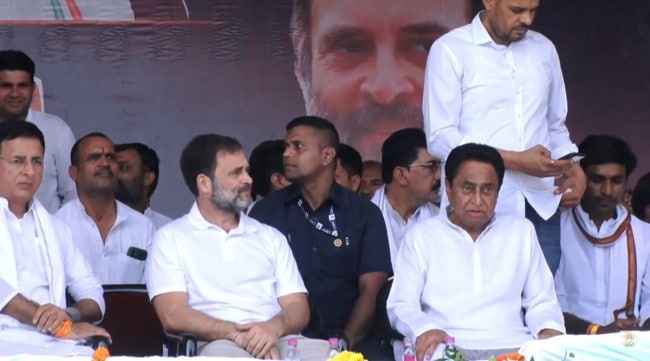Opinion Why Congress lost Madhya Pradesh: Unlike Telangana, it didn’t listen to advisers or notice BJP’s winning strategy
Rahul Gandhi went on harping on the theme of caste-based reservations without realising that he, in Madhya Pradesh, had far fewer credible OBC leaders to take this message home
 Congress leaders Rahul Gandhi and Kamal Nath at the Shajapur rally in Madhya Pradesh on Saturday. (Video screengrab/ Congress/ YouTube)
Congress leaders Rahul Gandhi and Kamal Nath at the Shajapur rally in Madhya Pradesh on Saturday. (Video screengrab/ Congress/ YouTube) Unlike the campaign led by Revanth Reddy in Telangana, the Congress in Madhya Pradesh lacked aggression and bravado. And the party paid a heavy price.
Kamal Nath seemed convinced in the run-up to the assembly elections that “Madhya Pradesh ki janata ne apna mann bana liya hai. MP ka election janata aur BJP ke beech mein hai” (Voters in Madhya Pradesh have made up their minds — the contest in MP is between the people and the BJP.) The situation on the ground was clearly different — the seemingly silent voter seems to have made her choice based on welfarism, the Modi factor and the Ram temple. Nath overruled in-house poll strategist Sunil Kanugolu who wanted drastic changes in the Congress list of candidates, talking points and campaign design.
AICC chief Mallikarjun Kharge, Rahul Gandhi and AICC general secretary in charge of the state, Randeep Surjewala, remained mute spectators even though in private, they often questioned Nath’s strategy.
On the other side, both Prime Minister Narendra Modi and Amit Shah kept harping on the theme of Ram temple construction throughout the campaign. This was in addition to dozens of sadhus, saints and katha vachaks travelling across the state, congratulating voters and explaining how a grand temple in Ayodhya had become a reality thanks to an individual and a political party. Nath’s plank to project himself as a Hanuman bhakt, sanatan dharmi and devout Hindu did not help the Congress cause.
Addressing election rallies at Satna, Damoh, Chikrakoot and several other places, Modi emphasised how his government’s commitment to build and deliver four crore houses was similar to his dedication to building the Ram temple. At the temple town of Ujjain, Shah told the voters that he wished to convey to Rahul Gandhi that the date of the inauguration of the Ram Temple in Ayodhya had been announced. “Between 2014 and 2019, when I was the party (BJP) president, Rahul baba used to say in every election that ‘the BJP folks will say mandir wahin banayenge magar tithi nahi batayenge (we will make the temple right there, but won’t tell the date)’. He used to taunt us,” Shah said, confirming January 22, 2024, as the date for the temple’s inauguration.
While the Congress relied heavily on Nath and Digvijaya Singh, the BJP’s strategy was drastically different and much more hands-on. The BJP parliamentary board’s decision to field three Union ministers, seven Lok Sabha MPs and a national party functionary initially appeared a bit odd and a sign of weakness, but in effect, it took a leaf out of the old Congress playbook. Back in the days of undivided MP, (before the formation of Chhattisgarh), the Congress used to put in play the Shukla brothers, Arjun Singh, Madhavrao Scindia, Kamal Nath, Digvijaya Singh, P C Sethi, Motilal Vora, Ajit Jogi, Subhash Yadav, Jamuna Devi and other regional satraps. These regional satraps, in turn, would compete among themselves to shore up the Congress prospects in their respective regions and areas of influence. This time around, the BJP had Narendra Singh Tomar, Prahlad Patel, Phagan Singh Kulhaste, Ganesh Singh, Rakesh Singh, Riti Pathak and Kailash Vijayvargiya to contest assembly polls and provide maximum dividends in their areas of influence. The outcome has been outstanding.
While these BJP warriors were in the fray, Jyotiraditya Scindia worked hard, going door-to-door in the Gwalior-Chambal region. Scindia stepped up his efforts when Priyanka Gandhi mocked his height and political stature. The transformation of a “maharaj” to a “bhai saheb” helped the BJP overcome a strong sense of anti-incumbency against the sitting MLAs in the Gwalior-Chambal region. The Congress erroneously kept hoping and counting on the division and differences between the Scindia camp and the BJP, but failed to realise how the two sides had closed ranks under pressure from the party.
Shivraj Singh Chouhan too played his role to near perfection. Instead of getting intimidated or isolated by the presence of central ministers and central observers, he struck an emotional chord with the voters, particularly women. He underscored schemes targeted at women. The Chouhan administration closely monitored and ensured that direct cash benefits were transferred to women beneficiaries swiftly and around the time of voting.
Oblivious to these factors, Rahul Gandhi went on harping on the theme of caste-based reservations without realising that he, in Madhya Pradesh, had far fewer credible OBC leaders to take this message home. The Congress, instead lost a chunk of Rajput-Brahmin votes, which consolidated towards the BJP.
The grand old party faces an uncertain and bleak future in Madhya Pradesh. The ageing Nath and Digvijaya Singh have played their innings to help BJP emerge as the dominant political party in Madhya Pradesh. The likes of Jitu Patwari, Kamleshwar Patel, Jaivardhan Singh and Nakul Nath will need years in the opposition benches before becoming effective against the BJP.
Kidwai is a journalist and writer





